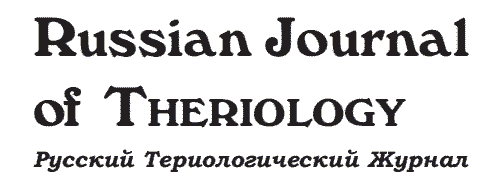A new subspecies of Manchurian pika Ochotona mantchurica (Lagomorpha, Ochotonidae) from the Lesser Khinggan Range, China
Lissovsky A.A.
P. 145-152
I examined 14 craniometric features of 128 specimens of Ochotona mantchurica from the entire distribution range. A craniometric analysis revealed at least three major groups with detached geographical distribution. The race of O. mantchurica from the southern part of the Lesser Khinggan Range has the same level of morphological peculiarity as two other subspecies: O. m. scorodumovi from the Russian Transbaikalia and O. m. mantchurica from the Greater Khinggan Range, together with the northern part of the Lesser Khinggan Range. The distribution area of this race is separated from the rest of the species distribution range by a wide band of lowly suitable habitats. No nominal taxa were described from the southern part of the Lesser Khinggan Range, and the race in question was described here as a new subspecies: O. m. loukashkini ssp. nov.
DOI: 10.15298/rusjtheriol.14.2.03Литература- Burnaby T.P. 1966. Growth-Invariant Discriminant Functions and Generalized Distances // Biometrics. Vol.22. No.1. P.96-110.
- Feng Z. & Zheng C. 1985. Studies on the pikas (genus Ochotona) of China - taxonomic notes and distribution // Acta Theriologica Sinica. Vol.5. No.4. P.269-290 [in Chinese and English].
- Formozov N.A. & Baklushinskaya I.Y. 2011. [Manchurian pika (Ochotona mantchurica scorodumovi) from the interfluve of the Shilka and Argun Rivers: karyotype and problems of pika taxonomy in Amurland and adjacent territories] // Zoologicheskii Zhurnal. Vol.90. No.4. P.490-497 [in Russian].
- Hijmans R.J., Cameron S.E., Parra J.L., Jones P.G. & Jarvis A. 2005. Very high resolution interpolated climate surfaces for global land areas // International Journal of Climatology. Vol.25. No.15. P.1965-1978.
- Hoffmann R.S. & Smith A.T. 2005. Order Lagomorpha // Wilson D.E. & Reeder D.M. (eds.). Mammal species of the world: a taxonomic and geographic reference. 3rd. ed. Baltimore, MD: John Hopkins Univ. Press. Vol.1. P.185-211.
- Lissovsky A.A. 2003. Geographical variation of skull characters in pikas (Ochotona, Lagomorpha) of the alpina-hyperborea group // Acta Theriologica. Vol.48. No.1. P.11-24.
- Lissovsky A.A. 2004. Contribution to age determination of pikas (Lagomorpha, Ochotonidae, Ochotona) // Russian Journal of Theriology. Vol.3. No.1. P.43-48.
- Lissovsky A.A. 2005. [Comparative analyses of the vocalization of pikas (Ochotona, Mammalia) from alpina-hyperborea group] // Byulleten' Moskovskogo Obshchestva Ispytateley Prirody. Otdel Biologicheskii. Vol.110. No.6. P.12-26 [in Russian].
- Lissovsky A.A. 2014. Taxonomic revision of pikas Ochotona (Lagomorpha, Mammalia) at the species level // Mammalia. Vol.78. No.2. P.199-216.
- Lissovsky A.A., Ivanova N.V. & Borisenko A.V. 2007. Molecular phylogenetics and taxonomy of the subgenus Pika (Ochotona, Lagomorpha) // Journal of Mammalogy. Vol.88. No.5. P.1195-1204.
- Lissovsky A.A., Yang Q. & Pilnikov A. 2008. Taxonomy and distribution of the pikas (Ochotona, Lagomorpha) of alpina-hyperborea group in North-East China and adjacent territories // Russian Journal of Theriology. Vol.7. No.1. P.5-16.
- Marcus L.F. 1993. Some aspects of multivariate statistics for morphometrics // Contributions to morphometrics. Vol.8. P.95-130.
- Mina M.V. & Klevezal G.A. 1976. [Growth of Animals]. Moscow: Nauka. 291 p. [in Russian]
- Nikol'skii A.A. 1984. Sound Signals of the Mammals in the Evolutionary Process. Moscow: Nauka. 199 p. [in Russian]
- Niu Y., Wei F., Li M., Liu X. & Feng Z. 2004. Phylogeny of pikas (Lagomorpha, Ochotona) inferred from mitochondrial cytochrome b sequences // Folia Zoologica. Vol.53. No.2. P.141-156.
- Obolenskaya E.V., Lee M.-Y., Dokuchaev N.E., Oshida T., Lee M.-S., Lee H. & Lissovsky A.A. 2009. Diversity of Palaearctic chipmunks (Tamias, Sciuridae) // Mammalia. Vol.73. No.4. P.281-298.
- Ognev S.I. 1940. [Mammals of the USSR and Adjacent Countries]. Moscow-Leningrad: Izdatel'stvo AN SSSR. Vol.4. 616 p. [in Russian]
- Phillips S.J., Anderson R.P. & Schapire R.. 2006. Maximum entropy modelling of species geographic distributions // Ecological Modelling. Vol.190. No.3-4. P.231-259.
- Phillips S.J. & Dudik M. 2008. Modeling of species distributions with Maxent: new extensions and a comprehensive evaluation // Ecography. Vol.31. No.2. P.161-175.
- Smith A., Formozov N., Hoffmann R., Zheng C. & Erbajeva M. 1990. The pikas // Chapman J.A. & Flux J.E.C. (eds.). Rabbits, hares and pikas: status survey and conservation action plan. Gland, Switzerland: IUCN. P.14-60.
- Sokolov V.E., Ivanitskaya E.Y., Gruzdev V.V. & Heptner V.G. 1994. [Mammals of Russia and Adjacent Regions: Lagomorphs]. Moscow: Nauka. 272 p. [in Russian]
- Statsoft Inc. 2007. STATISTICA (data analysis software system), version 8.0. www.statsoft.com
- Yakhontov E.L. & Formozov N.A. 1992. [Systematic revision of the pika's species complex Ochotona alpina-Ochotona hyperborea. 1. Geographic variation in Ochotona alpina] // Vestnik Moskovskogo Universiteta. Biologiya. No.1. P.27-33 [in Russian].
Скачать PDF
|

